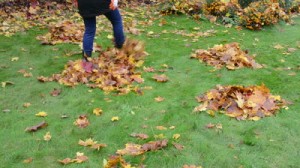The barbecue and garden party season is nearly over, save for the odd impromptu cookout on those warm autumn weekends, and no doubt your lawn has borne the brunt of several events. Lots of people walking and standing on the ground leads to compacting of the soil, and bare patches where garden furniture has been standing. Now is the time to make some preparations and reparations to see your lawn through the winter and early spring.
Thank you for reading this post, don't forget to subscribe!

Firstly, mow the lawn but don’t cut the blades of grass too short; the next steps are intended to improve the health of your lawn and in order for these to work the grass blades need to be long enough to photosynthesise effectively.
If your lawn sees a lot of footfall (especially if you have children that play football games on it every day during the holidays) the soil can become compacted which hinders the healthy growth of grass. Aerating the lawn by making tiny holes in the surface can help break up compacted soil and allow the ground to breathe properly. Aerating tools are available to purchase or hire, but for small lawns a garden fork will do the job, although it will take a little time to cover the whole area. Once the lawn is aerated the water and air can move more freely around the grassroots, and will mean the lawn will cope well with heavy rain; instead of water pooling on the surface it can soak into the soil and help feed the lawn.
Aerating doesn’t need to be done every year; the average lawn will benefit from this process every three to four years but there may be areas that require a quick spiking every year. Areas around a built-in barbecue, around a washing line and, if you have sporty kids, areas where they practise penalty-taking will take more of a battering than the rest of the lawn and will need a little more attention.
If moss is a problem in your lawn, perhaps in areas of shade, then scarifying (raking these layers off the lawn surface) should be done in the autumn, giving the grass plenty of time to recover over the winter. Once the lawn surface has been treated with scarifying and aerating techniques then it is time to top-dress. This is especially important for lawns that have been aerated as the top dressing fills the holes that have been created and improves the drainage and soil quality.
Top-dressing mix is made from three parts sandy loam, six parts sand and one part compost (homemade is fine as long as it is not too coarse). If your soil is very sandy already the sand part can be reduced and the loam component increased. The top-dressing is applied over the lawn surface at a volume of roughly two kilos per square metre and worked in with the back of a rake. The idea is to spread it evenly without disturbing the grass too much, and without further compacting the soil. If you have problems with fungal infections and pests in the lawn then you can add treatments to the top-dressing mix to address these issues at the same time.
The compost and loam in the top-dressing mix will help fertilise the soil and reintroduce nutrients into the ground that will help the grass recover from any drought periods and improve the health of the lawn in general. Once these treatments have been applied try and stay off the lawn for a few days for the effects to start to take hold. Water the grass if there is no rain for a few days following any restorative work, and by the spring you should see an improvement in the quality of your lawn, ready for the footfall of the barbeque season to begin again!
